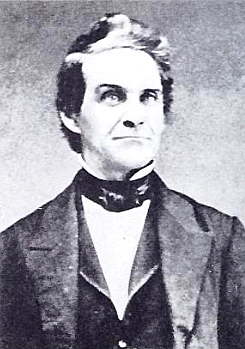William Howell wrote the 1864 abortion ban in Arizona. He modeled it after California
Election 2024, Abortion, Homepage News
Believe E. Pinho Scott WilsonApril 10, 2024
It was the era of the Wild West, when white men from the east poured into Arizona to harvest the land’s golden wealth, take over territories and establish laws.
William Howell, a New Yorker charged with writing the code that would enshrine Arizona as a territory, opened the law books of a neighboring state as a model: California. He copied parts of the state law, including a section that criminalized abortions except when a mother’s life was in danger.
And on Tuesday, 160 years later, Howell’s words became relevant again, when the Arizona Supreme Court ruled that the state would return to the original abortion law, which would have banned doctors in all cases except when a mother’s life is in danger .
“History does not happen in a vacuum,” said Melanie Sturgeon, a retired state archivist and co-founder and president of the Arizona Women’s History Alliance. “You have to understand what’s going on … in the area or state and those next to us, and what’s happening nationally and what’s affecting us.”
California, with its promises of gold, began to attract a stream of visitors from the East in the late 1840s, and quickly amalgamated to form the first state in the West in 1850. California’s neighbors to the
southeast
soon followed. In late 1863, Arizona seceded from New Mexico and became its own fledgling territory.
The following year, Anglo-American men traveled from the East to set up Arizona’s founding structure. One of those important early figures was Howell. Born and raised on a farm in New York, Howell began teaching at age 16, became a newspaper editor at 19, and practiced law at age 24, John Goff wrote in his article “William T. Howell and the Howell Code of Arizona.”

Howell was married three times and remarried after both his first and second wives died and had children with each of the women, according to Goff. He spent much of his adult life in Michigan, rising through the ranks of the state legislature and serving twice as speaker pro tem before heading to Arizona.
“Howell is a rather shadowy figure, unremembered in Arizona, and largely forgotten in his home state of Michigan,” Goff wrote.
In 1862, then President
Abraham
Lincoln wrote, “When the Arizona Territory shall be organized, let William T. Howell, of Michigan, be appointed judge therein.”
Howell moved to Arizona the following year and quickly established a court in Tucson. In the middle of the civil war
w
As he ravaged the country, Howell delivered a speech to an assembled grand jury that “dwelt at length on the necessity of protecting the rights of the people by affording equal justice to all,” Goff wrote.
As one of his first duties as a judge in Arizona, Howell “searched the statute books of California, New York, and other states for laws appropriate to the territory,” according to the 1970 book “Arizona Territory, 1863-1912; A Political History” by Jay Wagoner.
“Arizona has essentially copied California law,” Sturgeon said.
In the laws of California, Howell found and incorporated his provision on abortion almost word for word. The paragraph is tucked into a section of the Arizona code dealing with the penalty for poisoning another
human person
:
“And any person who shall administer or cause to be administered or ingested any medicinal substance, or shall use or cause to be used any instrument whatsoever, with the intention of procuring the miscarriage of any woman then pregnant, and shall be duly convicted thereof, shall be punished,” according to both the California and Arizona codes, adding that a physician will be exempt from the law “who, in the performance of his professional duties, deems it necessary to induce a miscarriage of a woman in order to save her.” to live.”
Howell earned a total of $7,500 for his work while on the job, and the honorary title of Arizona’s founding document was called “the Howell Code,” according to Wagoner’s book.
“Part of the reason I think this will become part of the law in the West
,
“I don’t think they would care much if Mexicans and Indians had abortions, but they were very concerned.”
The birth rate had been declining since the early 19th century, Sturgeon said, as industrialization advanced.
human families
from farms to cities, reducing the need for as many children as possible to support their families.
Although modern abortion laws vary from state to state, some include exceptions for rape or incest. Arizona’s original code was strict. That was fairly typical for the time because, Sturgeon noted, the age of consent in Arizona was 10.
“It was just assumed that if you got pregnant as a 10-year-old, you had seduced that uncle, that neighbor, that older brother or whatever,” she said. “And so there is nothing in our laws about rape or incest.”
Sturgeon said she has read court transcripts of judges and juries questioning children about their role in attracting an older man.
“There’s a poor kid carrying a baby
Unpleasant
term… which brings with it all the trauma of being abused and impregnated by a family member or a family friend, and they have to live with that for the rest of their lives,” she said, “because it was just assumed that they the to seduce someone.”
Not long after Arizona’s code was created, ads for self-managed abortions began appearing in newspapers, Sturgeon said. The ads used the same term as the Arizona code “medical substances” to describe abortions.
“Every time you saw an ad that said ‘Portuguese medication,’ it was a euphemism for ‘This will cause an abortion,'” she said.
Howell’s stay in Arizona did not last long. As Goff writes, Howell received word that his third wife had also fallen ill in Michigan, “and might not live until the judge came home.” Howell took a leave of absence from his job in Arizona to return to his dying wife’s side.
He probably never returned to the West.
Fernando Dowling is an author and political journalist who writes for 24 News Globe. He has a deep understanding of the political landscape and a passion for analyzing the latest political trends and news.



